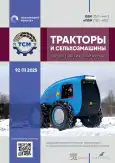Колориметрическая оценка содержания озона в воздухе в процессе сушки зерна
- Авторы: Кирмасов В.Ю.1, Звягин А.А.1, Баскаков И.В.1
-
Учреждения:
- Воронежский государственный аграрный университет имени Императора Петра I
- Выпуск: Том 92, № 1 (2025)
- Страницы: 10-16
- Раздел: Экологически чистые технологии и оборудование
- URL: https://bakhtiniada.ru/0321-4443/article/view/314149
- DOI: https://doi.org/10.17816/0321-4443-633262
- EDN: https://elibrary.ru/ZFCIHB
- ID: 314149
Цитировать
Полный текст
Аннотация
Обоснование. Внедрение современных технических средств и экологически чистых технологий в сельское хозяйство является актуальной задачей для нашей страны. Рассматриваются вопросы защиты растений, сохранения урожая и повышения качества сельскохозяйственной продукции на основе внедрения инновационных технологий. Одним из перспективных методов воздействия на семена является обработка озоном. Это обусловлено эффективностью воздействия озона как окислителя на биохимические процессы и обмен веществ. В связи с этим становится актуальным проведение исследований, направленных на выявление оптимальной концентрации озоно-воздушной смеси, и оценка эффективности озонирования при сушке зернового материала.
Цель исследования — создание тест-полосок для определения различных концентраций озоновоздушной смеси в воздухе.
Методы. В процессе исследования использовались методы качественных химических взаимодействий и математической обработки результатов. Принцип химического метода заключается в косвенном определении содержания озона по количеству реактива, вступившего в реакцию с озоном. Так при взаимодействии йодистого калия с озоном происходит восстановление йода. При этом его количество пропорционально концентрации озона в газовой смеси, которая была пропущена через раствор.
Результаты. Предложена методика, позволяющая определять концентрацию озоновоздушной смеси колориметрическим способом. Были созданы тест-полоски, а также присвоены каждому цвету численные значения в программе, которые соответствуют определённой концентрации озоновоздушной смеси.
Заключение. Проведённые исследования позволили создать методику определения концентраций озона в озоновоздушной смеси колориметрическим способом. Для концентрационной зависимости необходимо линейное отношение аналитического сигнала от времени экспозиции. Для этого достаточно пяти минут, при этом двукратное изменение концентрации соответствует двукратному увеличению отклика. Полученные тест-полоски позволяют определять концентрацию озона, необходимую для эффективной сушки посевного материала. Однако доработка данной методики и масштабное тестирование позволят значительно расширить область применения и повысить её надежность.
Ключевые слова
Полный текст
Открыть статью на сайте журналаОб авторах
Владислав Юрьевич Кирмасов
Воронежский государственный аграрный университет имени Императора Петра I
Автор, ответственный за переписку.
Email: vlad.kirmasov@mail.ru
ORCID iD: 0000-0002-8013-2016
SPIN-код: 8839-9882
аспирант кафедры сельскохозяйственных машин, тракторов и автомобилей
Россия, 394087, Воронеж, ул. Мичурина, д. 1Алексей Алексеевич Звягин
Воронежский государственный аграрный университет имени Императора Петра I
Email: a.a.zviagin@rambler.ru
ORCID iD: 0000-0002-9299-6639
SPIN-код: 4703-8716
кандидат хим. наук, доцент, доцент кафедры химии
Россия, 394087, Воронеж, ул. Мичурина, д. 1Иван Васильевич Баскаков
Воронежский государственный аграрный университет имени Императора Петра I
Email: vasich2@yandex.ru
ORCID iD: 0000-0001-6041-5943
SPIN-код: 5982-7572
доктор с.-х. наук, профессор, профессор кафедры сельскохозяйственных машин, тракторов и автомобилей
Россия, 394087, Воронеж, ул. Мичурина, д. 1Список литературы
- Baskakov IV, Chistokhvalov VV. The influence of ozone on the grain drying process. In: Priority vectors of industrial and agricultural development: materials of the I International Scientific and Practical Conference. April 26, 2018; Makeyevka. 2018;3:31–36. (In Russ.) EDN: UYZXSO
- Geniatulina IA, Zueva ON. Experience and prospects of ozone application in crop production. In: Scientific support for innovative development of the agro-industrial complex of the regions of the Russian Federation: Materials of the international scientific and practical conference, Lesnikovo, February 06, 2018; Lesnikovo. 2018:474–478. (In Russ.) EDN: YRONEU
- Tsokur ES. Application of the ozonation process in agriculture. Colloquium-Journal. 2019;25-1(49):63–64. (In Russ.) EDN ATHMIP
- Shcherbina AA, Zverev IV. Application of technologies using ozone in agriculture. In: Scientific support of the agro-industrial complex: a collection of articles based on the materials of the 72nd scientific and practical conference of students based on the results of research in 2016, February 01, 2017; Krasnodar. 2017;646–648. (In Russ.) EDN: ZAEDUH
- Trotskaya TP, Golubets IE, Litvinchuk AA, et al. Prospects for the use of ozone in bioenergetic processes of drying and preservation of plant materials. In: Scientific and technical progress in agricultural production: Proceedings of the International Scientific and Practical Conference. In 3 volumes, Minsk, October 21–22, 2009; Minsk: Republican Unitary Enterprise “Scientific and Practical Center of the National Academy of Sciences of Belarus for Agricultural Mechanization”. 2009;7–14. EDN: (In Russ.) EDN: URESNY
- Konovalov SA. Features of technology and modern devices for producing ozone. Environmental Bulletin of Donbass. 2023;8:16–21. (In Russ.) EDN: HXHCDE
- Belov EL, Dolgov NR, Vereshchak AV. Technical education of ozone for storage of agricultural products. In: Scientific and educational environment as a basis for the development of the intellectual potential of agriculture in the regions of Russia: Proceedings of the III International Scientific and practical Conference, September 08, 2023; Cheboksary. 2023;288–290 (In Russ.) EDN: ZYTFOQ
- Akinshin KG. Obtaining and application of ozone. In: Science, technology, production. November 25–26, 2015; Stavropol. 2015;11–14. (In Russ.) EDN: VHHUSB
- Agalakova LM, Kosolapov EV, Kuznetsov VN. Aspects of the use of ozonators in medicine. In: Society. Science. Innovations (NPC-2017): collection of articles. All-Russian Annual Scientific and practical Conference, April 01–29, 2017; Kirov. 2017;599–604. (In Russ.) EDN: NTAROL
- Samoilovich VG, Draginsky VL. Perspective designs of ozonators. Water supply and sanitary engineering. 2007;4:33–38. (In Russ.) EDN: HYVBGZ
- Shustov DA, Bakulina LA. A simplified method for determining ozone and nitrogen dioxide in their combined presence in the air. Hygiene and sanitation. 1975;12:69–71. (In Russ.)
Дополнительные файлы














